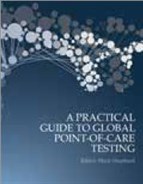A practical guide to global point-of-care testing
Mark Shephard, editor
Melbourne: CSIRO Publishing, 2016
ISBN 9781486305186

As a busy medical editor, I see a large number of textbooks pass across my desk, encompassing a broad range of topics. Although all ostensibly make for interesting reading for their target audience, few are at the cutting edge of clinical practice. Hence my delight when A practical guide to global point-of-care testing arrived recently. This book is a new, comprehensive and detailed guide to the paradigm shift in how point-of-care testing (POCT) is being incorporated into everyday clinical practice.
POCT is when medical diagnostic examination is conducted proximal to the patient’s bedside to provide real-time input into clinical decision making. The idea of POCT has been around for a generation, yet, only relatively recently has the technology been sufficiently affordable and robust to influence the clinical space in large numbers. Importantly, this book moves far beyond the few basic tests to a comprehensive suite of investigations to match the reader’s location and needs. With few competitors in print, this first edition fills a quantifiable gap across this rapidly developing field.
The editor, Professor Mark Shephard, is uniquely qualified for the task as he is the director of the Flinders University International Centre for Point-of-Care Testing (the Centre) in Adelaide, Australia and the program manager of the International Analytical and Clinical Excellence Point-of-Care Testing Program for diabetes management, which now operates in seven countries. Professor Shepherd is also the course coordinator for the Centre’s Graduate Certificate in Global Point-of-Care Testing, which is the first postgraduate academic qualification in the field of POCT, and the inaugural convenor of The World Organization of Family Doctors’ (WONCA’s) Special Interest Group on Global Point-of-Care Testing. Professor Shephard’s extensive knowledge of those in the field assisted him in commissioning an impressive array of chapter authors from across the world to address the appropriate, wide-ranging set of topics covered.
The book is written in a practical and pragmatic style, with a clear emphasis on guiding the effective introduction of POCT. Apart from a solid accounting of clinical considerations, the book also provides an analysis of the logistical, financial, purchasing and other related issues. Hence, the book is aimed across the range of disciplines necessary for the effective introduction and maintenance of POCT in the clinical environment. The depth of analysis of each topic positions the book as an impressive hardbound reference work, yet the style allows for those who prefer to read cover-to-cover.
The early chapters discuss managing POCT services, while the remainder considers POCT from the perspective of specific diseases or clinical settings, including general practice. Hence, the audience of this book is predominantly those whose clinical setting has POCT in place, or is considering incorporating POCT into their clinical practice. As this book is targeting a global audience, it is not specific to the Australian context, with only limited consideration of the challenges Australian general practitioners (GPs) would have in adopting POCT in the absence of a formal funding arrangement. In that context, POCT may be of most interest to Australian readers working in non–Medicare funded environments, rural medicine, Aboriginal and Torres Strait Islander peoples’ health, sports medicine and austere or remote environments.
In the international context, there are specific chapters on malaria, tuberculosis, Ebola and aspects of other diseases of most interest to those working outside countries with advanced economies.
In summary, for those with a keen interest in the topic, this comprehensive book may prove to be a cornerstone in the maturation of this important component of clinical practice.
Professor Stephen A Margolis
Senior Medical Editor, Australian Family Physician
Erratum
Marino JL, Lewis LN, Bateson D, Hickey M, Skinner SR. Teenage mothers.
Aust Family Physician 2016;45(10):712–17.
In the ‘Authors’ section, Deborah Bateson’s qualifications, appointments and affiliations were incorrectly listed. The correct details are:
Deborah Bateson MA, MSc, LSHTM, MBBS, Medical Director, Family Planning New South Wales, Sydney, NSW; Clinical Associate Professor, Discipline of Obstetrics, Gynaecology and Neonatology, University of Sydney, Sydney, NSW
The correction has been made to the HTML and PDF versions of this article.
We apologise for this error and any confusion it may have caused our readers.